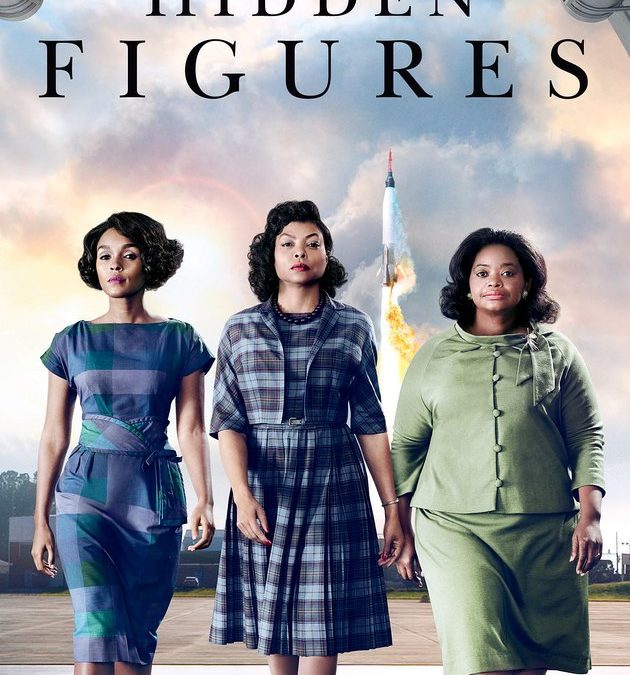Hidden Figures, starring Taraji P. Henson, Octavia Spencer, Janelle Monáe
–Review by Ashley Linne
This film is rated PG.
This movie combines two of my favorite things: strong women and space. Hidden Figures tells the true story of the history-making triumphs of three female African American NASA mathematicians: Katherine G. Johnson, Dorothy Vaughan, and Mary Jackson. The incredible story unfolds in the 1960s space race and civil rights era, and until very recently was totally unknown to the public.
Given the serious nature of the cultural backdrop, this film is anything but solemn. The optimism, humor, and determination of the three main characters are contagious. These women are bona fide heroes, but also extremely relatable. The challenges they face are universal for women yet particular for them as women of color, and their incredible strength to overcome is inspiring. The soundtrack is just as buoyant. Hidden Figures includes all the formulae of an enjoyable film. But don’t be fooled into thinking it is a “chick flick.”
The title of the film invites the audience to search beyond what seems obvious. To this end, the filmmakers utilize both dialogue and silence throughout the movie. A couple of central lines of dialogue center around “looking beyond.” Al Harrison, Katherine’s gruff but ultimately supportive boss played by Kevin Costner, says to her, “What I’m asking everyone one in that room to do, all my geniuses, is to look beyond the numbers. To look around them. Through them. For answers to questions we don’t even know to ask.”
This film deserves more than one viewing to be unpacked from a semiotic standpoint. I’m sure there are many gems waiting to be uncovered: for instance, the use of color (our three main characters are frequently dressed in vibrant colors, which makes them stand out against the sea of white button-up shirts of their costars; thus, the women are hidden in plain sight). We don’t have space here to explore all the imagery, but two images surrounding Katherine’s character did stick with me well from the start.
Chalk. Twice in the film, once as a child and again as an adult, Katherine is handed chalk and invited to work out complicated equations on the chalkboard. The shot zooms in on the handing of the chalk from the male authority figure to Katherine. This action really spoke to me. The chalk served as a symbol of authority and sharing knowledge. These men were empowering Katherine to do what they knew only she could do. I wonder how many “hidden figures” are in our churches, waiting to be trusted and supported by those of us in authority. It’s frequently stated throughout Hidden Figures that the limitations and barriers of their culture are “just the way things are.” What status quos in our churches need to be challenged? Who are the people ready for the next step, just waiting for a mentor to “pass the chalk”?
Katherine’s coffee mug. A poignant moment in the film is when Katherine casually fills her coffee mug from the only pot in the room, to the shock of all her white coworkers. The next day a coffee pot labeled “Colored” appears. At one point later, Katherine justifiably breaks down and shouts to them the absurdity that they won’t even touch “her” coffee pot. In the film’s closing scenes, Paul Stafford, Katherine’s oppressive coworker played by Jim Parsons, is seen bringing a seated Katherine the mug full of coffee. These quiet moments have no dialogue but speak volumes. Paul’s action is subtle but moving, as he seems to finally acknowledge Katherine’s humanity and her greatness. Who are the hidden figures in our churches who need to be honored through our service to them? Who are the “untouchables” of our society and how do we get past ourselves to recognize and uphold their innate worth?
I love movies with happy endings, and this film is chock full of them. However, if I “look beyond” the film, I’m reminded that happy endings were not always the case in that time and sometimes not still today. In His ministry, Jesus continually valued, liberated, and empowered those who were “hidden” from the mainstream of society and synagogue, and he opened the eyes of those blinded to the all-inclusiveness of God’s love. What steps can we take in our communities and in our churches to reveal the hidden gifts of our sisters and brothers that are right before our eyes? In what ways can we come together to bring our own “hidden” assumptions and hidden bias’ into focus, as we live out the gospel in our lives and in our churches?
Interview with the film’s director, Theodore Melfi: http://lrmonline.com/news/the-lrm-interview-with-hidden-figures-director-theodore-melfi
Interview with the film’s screenwriter, Allison Schroeder: https://www.flickeringmyth.com/2017/02/exclusive-interview-oscar-nominated-screenwriter-allison-schroeder-on-hidden-figures-oscarssowhite-and-more/
The best-selling book Hidden Figures: The American Dream and the Untold Story of the Black Women Mathematicians Who Helped Win the Space Race by Margot Lee Shetterly is available at bookstores and on Amazon.

